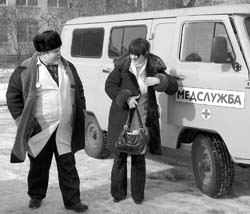Not enough doctors
Ukraine will have enough physicians only in 10 years
According to the World Health Organization’s world health report 2006, the world lacks four million physicians. This is how many physicians are needed to overcome the chronic manpower shortage in this sphere. As usual, African countries are the worst off, but the shortage of medical personnel is also an acute problem in Ukraine. During a seminar dedicated to World Health Day, Ukrainian scientists noted that this country still needs more than 20,000 physicians.
In the past several years Ukraine has set a clear course for developing family medicine. Statistics show that 70 percent of patients prefer to consult so- called first-line physicians. But only a mere 11 percent of all Ukrainian doctors are engaged in this sector. Medical care is thus seldom provided during the first visit. The patient is directed to another physician, who specializes in a particular branch of medicine and only then does treatment begin. In this situation family medicine is exactly what is needed.
Whereas in the past every family was treated by two or three physicians (a village doctor, pediatrician, and one specializing in teenagers’ illnesses), now all problems are solved by only one specialist, who treats a patient from birth until old age. Western experience shows that with this kind of system people fall sick less often because the family doctor knows everything about his patients and can forestall a disease in a timely fashion.
However, this is in theory. In actuality, implementing this approach comes up against local budgets entrusted with the task of forming and maintaining family-type outpatient facilities. If a village council chairman scrapes up some money and is helped by local businessmen, this facility will be a reality and will have adequate equipment and supply of medications. Otherwise, physicians will have to use the good old-fashioned methods.
Physicians, especially graduates of medical schools, are not enthusiastic about this situation. Because of the low pay, hard work, and responsibility that far outweigh salaries, some three percent of all physicians and other medical workers quit every year. By late 2004, in Kyiv oblast alone, 43 specially trained and retrained physicians worked at 37 district hospitals and family outpatient departments. They took care of more 91,000 residents, in other words some 2,000 patients per physician. In such conditions the practice of even the most brilliant physician can hardly be described as family medicine.
According to Yevhen LATYSHEV, senior expert on general practice and family medicine at Ukraine’s Ministry of Health, the average physician is a woman aged 40-49, a medical school graduate without a “category.” As a rule, medical nurses in Ukraine are professionally trained and spend an average of 20 years in the medical field. At the same time, the highest monthly wages offered physicians amount to less than 1,500 hryvnias [less than $300].
A considerable number of recent medical school graduates quit the medical field because they are paid 420 hryvnias a month. This is exactly what Mykha ilo PURNYN, a therapist at a Kyiv hospital, is paid. “There are some 60 patients on our ward and 2.5 physicians along with several nurses,” says Mykhailo. “The physicians, especially the beginners, have no time to read up on certain cases. They have to make do with what they were taught in medical school, which is mostly pure theory.”
He adds that they can’t work effectively not only for lack of funds, but also because they need five or six nurses and two or three doctors. The last two or three generations of medical school graduates who chose practical medicine face another problem: the authority of general practitioners and family doctors is not clearly delimited. Who is supposed to examine patients, make prescriptions, and book surgeries? There is a legal framework, but somehow practicing physicians are not familiar with it.
The government had planned to provide Ukraine with enough medical personnel before 2010, but this goal cannot be achieved. At this stage there are only 150 medical lecturers and each trains approximately seven family physicians a year. In 2005 there were some 240,000 vacancies for physicians and other medical workers; 224 vacancies were occupied, but there were actually only 195,000 physicians.
Despite the fact that tens of thousands receive medical school diplomas every year, the number of vacancies is dropping slowly; the “old guard” — also young physicians — quit their jobs and seek employment elsewhere because of inadequate pay. According to the optimistic forecasts of Vitaliy MOSKALENKO, president of Bohomolets National Medical University, at this rate the problem will be solved only by 2015, provided other factors that lead many physicians to stop practicing are eliminated.
Personal problems are only the tip of the iceberg. Experts estimate that the budget is financing the medical sector by only 40 percent, and that even this money is being used irrationally, without considering the cost-effectiveness principle. The program-target budget-forming approach introduced in recent years, and centralized appropriations for the purchase of expensive equipment and vitally necessary medications have considerably improved the situation, but failed to provide a radical solution to the funding problem.
Lack of budgetary funds leads to the replacement of free medical assistance by paid care; the population is spending more on health care, mainly through unofficial payments. Within the finance structure that provides for medical institutions under state and municipal ownership, some 20 percent is channeled directly into the process of treatment (supply of drugs, food for special diets, medical equipment, etc.). Therefore, despite progress in medical care and constant expansion of specialized services, Ukraine still lacks an adequate level of prophylactics, diagnosis, treatment, and rehabilitation to maintain and strengthen peoples’ health.






